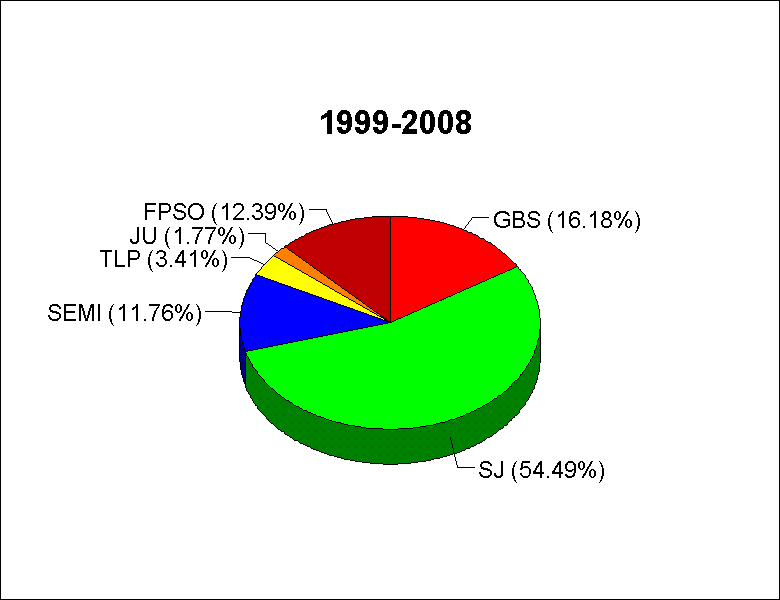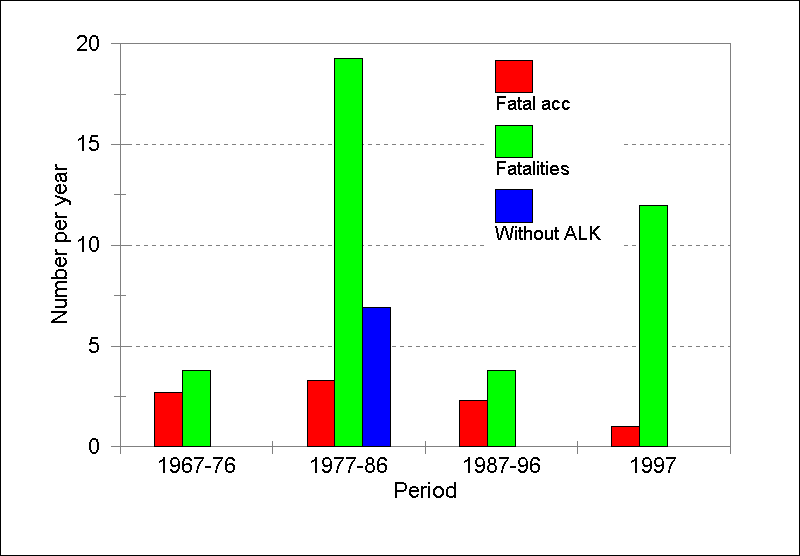The Preventor Risk Level project was the starting point for what later became the PSA RNNP – Risk Level in the Norwegian Petroleum sector. The Preventor Risk Level project took mainly a toward outlook, by predicting risk levels 10 years into the future, whereas the PSA Risk Level project reports performance of a large set of indicators in the past year and a ten year period.
You may download the main report free of charge from this location. The file is provided in PDF format.
Final report
The project has determined the historic risk levels – mainly in the past ten years – and the expected future risk picture on the Norwegian Continental Shelf during the next ten years, covering fatality risk to personnel, risk to the environment, as well as risk to assets. The presentation in this report is focused on the following types of installations and activities:
Fixed and floating production installations
- Mobile drilling units, including transit movements
- Standby, supply vessels, anchor handling tugs
- Diving vessels
- Pipe laying, crane vessels
- Helicopter transport to and between installations
- Pipeline transportation of oil and gas, tanker transportation of crude oil
The basis for establishing risk levels for historic and future periods is a precise and detailed mapping of all activities involved in the offshore operations on the Norwegian Continental Shelf in relation to operation of the above mentioned installations and operations.
Study Method
 The study method has included establishing comprehensive spreadsheets with key data for all production installations individually, on the basis of the field and platform names, with main operational features on an annual basis, historically for the period 1988 – 1997, and for the period 1999 – 2008. These spreadsheets also include known and possible future developments at specific field locations, with an anticipated field development solution. The work has been constructed as interlinked spreadsheets, which allow for quick and efficient conduct of the sensitivity studies.
The study method has included establishing comprehensive spreadsheets with key data for all production installations individually, on the basis of the field and platform names, with main operational features on an annual basis, historically for the period 1988 – 1997, and for the period 1999 – 2008. These spreadsheets also include known and possible future developments at specific field locations, with an anticipated field development solution. The work has been constructed as interlinked spreadsheets, which allow for quick and efficient conduct of the sensitivity studies.
The existing and future production and exploration wells in the Norwegian sector have been subdivided into four geographical regions. These regions, two of which are found in the North Sea, south of the 62nd parallel and two north of it, are considered to be significantly different with respect to environmental vulnerability. North of the 62nd parallel the fields are in average somewhat closer to shore, the prevailing wind direction is toward the coast, and there are a number of very sensitive areas for breeding of birds.
 For the other activities (i.e. exploration, pipe-laying, installation and decommissioning, use of various types of vessels) named data has not been established, but the activity levels have been modelled with respect to volume, both historically and for the future.
For the other activities (i.e. exploration, pipe-laying, installation and decommissioning, use of various types of vessels) named data has not been established, but the activity levels have been modelled with respect to volume, both historically and for the future.
The consideration of risk to personnel in the study is limited to fatality risk, whereas injuries are considered only in a few cases. When fatality risk is considered, there are mainly two categories, occupational accidents and major accidents, including helicopter accidents.
The study has taken a different approach to estimation of risk levels associated with major hazards, which is not based directly on accident statistics. The approach chosen is a ‘risk analysis approach’, i.e. failure frequencies are established for initiating events, and combined with unavailabilities of relevant barriers. These estimates have in some cases increased uncertainty, when there is quite limited operational experience. Nevertheless, this approach is in general considered to give estimates that have the lowest possible uncertainty, fully comparable with estimates that are commonly used in risk analyses.
Contents
- Summary of Approach
- Objectives and Scope of Work
- Study Method
- Historic and Future Activity Levels
- Use of Risk Estimates
- Study Implementation and Finance
- Summary of Trends – Risk to Personnel
- Overview of Accidents to Personnel
- Fatal Accident Rates
- Trends in Fatality Rates
- Risk Levels for Drilling Crew
- Risk Level for Helicopter Transport
- Comparison Offshore – Onshore Activity
- Future Risk Levels – Personnel
- Future Overall Fatality Risk Levels
- Comparison of past and Future Risk Levels – Risk to Personnel
- Sensitivity Studies
- Summary of Trends – Risk to Environment
- Blowout Risk
- Contributions to Oil Spill Risk
- Summary of Trends – Risk to Assets
- Overall Conclusions
- Risk to Personnel
- Environmental Risk
- Annex Definitions and Abbreviations
Appendices (in separate volume)
- Introduction to Study Approach
- Norwegian Continental Shelf Activity Levels
- Historic Risk Levels
- Modelling of Future Risk Levels
- Risk Exposure – Personnel
- Risk Exposure – Environment
- Risk Exposure – Assets
- Sensitivity Studies – Risk to Personnel
- Sensitivity Studies- Risk to the Environment
- Summary of Main Assumptions
